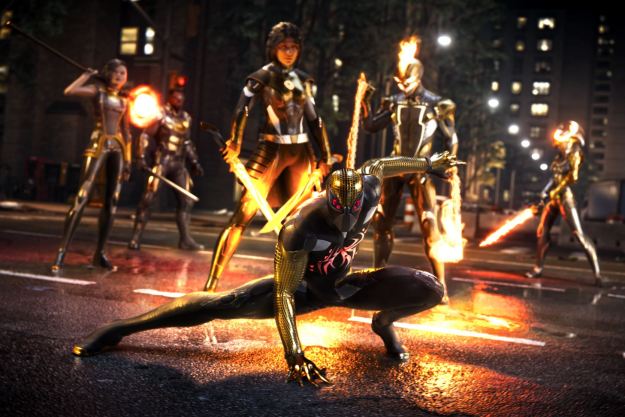The strategy genre has been seeing a resurgence in video games in recent years. Games like Fire Emblem: Three Houses and the rebooted X-COM series, plus upcoming titles like The DioField Chronicles, have finally given long-time fans new, high-quality entries in this niche genre while also introducing a new audience to the punishing but extremely satisfying mechanics it is known for. Triangle Strategy is one of the newest tactics games that caught the public eye, not just for being a faithful strategy title with a strong narrative but also for being the second game to utilize the beautiful 2D-HD pixel art style we first saw in Octopath Traveler.
Because the genre has seen so little representation in the past decade or so, Triangle Strategy is poised to be many RPG fans’ first major taste of the genre. While it is certainly not as impenetrable as some other games, the nature of tactics-style games is generally more complex than your average RPG, which could lead to information overload or even missing important mechanics or strategies completely. Triangle Strategy asks you to do more than just master a basic rock, paper, scissors combat system. Here are all the important tips and tricks you need to become a strategic mastermind.
See more
- The best strategy games
- The 10 best JRPGs of all time developed by Japanese studios
- The best RPGs for the Nintendo Switch
Understand tile colors

Battles can be visual overload at times. You have a bunch of units all on different tiles, with different colored lines, squares, and more on your screen that can make it hard to get a grip on what’s important. Panel tiles are not overly complex, and once you internalize them, will make the rest of combat flow much smoother during your journey.
When you begin a turn, you will see a bunch of different colored tiles for the character you’re controlling. Blue tiles represent all the spaces that character can move to that leaves them out of any enemy’s current attack range. In essence, these are all “safe” spaces you can move that character.
Purple tiles, on the other hand, pull double duty. They also represent how far you can move the character, but if the tile is purple rather than blue, that means you’re inside of at least one enemy’s attack range. That doesn’t guarantee they will be attacked, but they are in danger at the very least. You can see exactly which unit, or units, can attack your character should they move into a purple tile via the red arcing line that will go between the enemy and your unit.
After you have moved, or if you choose to remain still and go into targeting mode, the tiles will either be red or yellow. Red tiles show that character’s attack range. Most melee characters, for example, will have very short attack ranges of just one tile ahead, while ranged units such as archers and mages can attack much further. Yellow panels are for units that can deal AoE damage, which will all be represented by the yellow tiles.
Internalize these colors early so you can visually decode a battlefield on the fly and work out your strategy without accidentally moving a unit into a bad situation.
Plan ahead with turn order
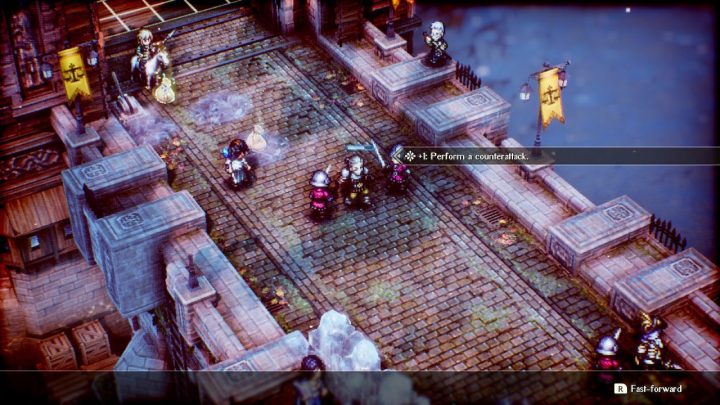
On the topic of strategy, the very bottom of the screen is where you can see the turn order for the battle. Each unit, friendly or enemy, has a speed stat. Depending on a unit’s speed, they will act sooner or later on the timeline. This should not be ignored. If you know you have two turns in a row, for example, you can put one unit temporarily in danger knowing that you have a second turn to take out the enemy that would otherwise have a chance to attack the first unit.
To get an even better idea of how turns will play out, highlight a blank tile on the map and hit the Y button. This will bring up the turn number on each character, making it a bit easier to visualize how combat will play out than just the basic timeline does.
Practice using Mock Battles
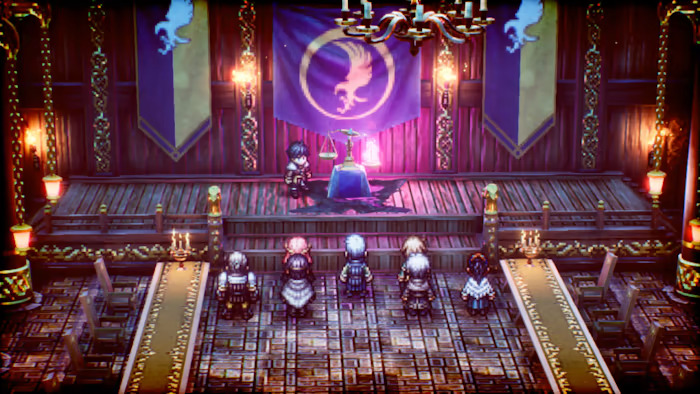
Triangle Strategy is a very story-heavy game, and while the combat is always great, there isn’t a lot of opportunity to interact with it outside of main and side quests. There are no random encounters to speak of like in a normal JRPG, so grinding in that way isn’t really an option, either for XP or just to test out new strategies. However, once you reach the game’s third chapter you will unlock Mental Mock Battles in the Tavern at your Encampment.
These mock battles are the closest thing you have to random battles, at least in terms of grinding and honing skills is concerned. Even though they’re “mock” battles, you will still earn XP for completing them like a real battle, so are well worth your time if you feel the challenge is a bit too tough for your next main mission. These all have a recommended level that steadily increases, and put you in new situations that encourage you to learn the ins and outs of combat.
These low-stakes battles are perfect for making sure you understand all the concepts in Triangle Strategy, and the bonus XP is just icing on the cake.
Do all your side quests first
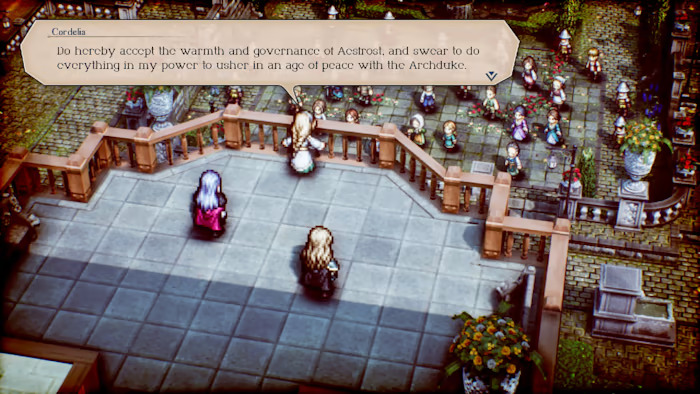
Speaking of quests, Triangle Strategy may not have random encounters, but it certainly has some side quests you can choose to take on if you want. Depending on what type of player you are, you may already want to do every side quest possible before the main quests, while others like to pace out doing side quests between main missions here and there. If you’re in the latter category, you may want to rethink that approach for this game.
While looking at your map, the red missions are your main missions that will progress the story, while green represents your side quests. No matter what you do, you can’t miss or avoid any red main missions, but the green ones will eventually go away. It might not be right after you beat the next main mission, but sometimes it will be, so if you want to be safe, and do as much as you can in Triangle Strategy, prioritize all those green spots first before moving on to the red ones.
Explore out of battle

Money, resources, and materials are all extremely important in Triangle Strategy, but they’re just as rare. You will likely never have enough of anything in the game, forcing you to make tough choices on what to buy and make. To ease the pressure just a little, spend time exploring every nook and cranny while you’re free to explore areas with Serenoa. Talk to all the NPCs, but also pay attention to the telltale sparkle of an item you can pick up in the environment. They won’t be much but they are better than nothing, and you only get one shot at claiming them since you can’t return to old areas after you leave.
Check friend and foe stats, weapons, and skills

Your party can have a total of 12 characters go into battle at once, which is a ton for most JRPGs, and even other strategy games. Then there are all the enemy units too, further complicating things. Aside from managing your team’s composition, you will still need some time to really internalize what every unit can do, plus learn what the enemy is capable of as well. This is where taking some time to check out all the details on each character comes in handy.
Hovering your cursor over an enemy will give you the basic rundown of their stats, but if you hit Y you can see a full breakdown of everything they have at their disposal, including weapons, abilities, skills, resistances, and weaknesses. The latter two are critical for maximizing your turns by making sure you use the correct unit to exploit enemy weaknesses whenever possible. You will also get a confirmation when targeting a unit if they are weak or resistant to that attack thanks to a little prompt popping up, but knowing before that point will help you decide how you want to position your entire team.
It’s a lot to take in, so don’t expect to memorize everything, especially as your own team evolves and gets new abilities. Having this tool to check all that vital information may slow things down a tad, but can mean the difference between a win and restarting the entire battle, which would cost way more time in the long run.
Positioning matters
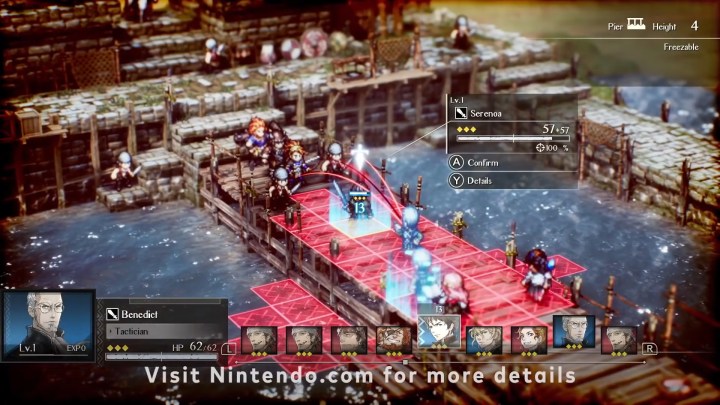
Triangle Strategy looks like a JRPG in many ways, which we previously mentioned. Whether you played Octopath Traveler, or find the 2D-HD art style reminiscent of classic JRPGs from the SNES era enhanced for the modern-day, then you may not be prepared for how integral positioning your team is in Triangle Strategy compared to a normal JRPG. In those games, positioning your units was either non-existent or very, very limited. With Triangle Strategy, you will be constantly moving and organizing your team to best overcome your enemy.
We already covered how tile colors work, but there’s more to positioning than just that. The environment is a major player in how fights will unfold. One of the smaller details that can be easy to forget is how different environmental effects impact battles. Pools of water will form if it is raining, if fire is cast in a snowy location, or an ice spell hits fire. If a lightning spell hits any pool of water, all units touching it will take damage. Or, hitting a tile with a fire spell can leave it burning for a while, damaging any who would touch it, but can also be spread if hit with a wind spell. Essentially, if a combination of elements makes sense, it will most likely work in Triangle Strategy, so creativity is highly rewarded.
A more simple, but equally important, part of positioning is height. Basically, every map you fight on will be multi-layered in some way, either with buildings, hills, or slopes inside of mines. If you have a unit attacking from an elevated position relative to their target, they will deal bonus damage to their target. This is easiest to do with ranged units, especially Hughette who can use her hawk mount to easily reach high elevation points which also increase her attack range.
If you’re all on ground level, then strike the enemy’s blind spot for extra damage when possible. Any hit coming in on a unit’s back will be a critical, which is obviously great, but also can be risky. Moving around behind an enemy can easily leave that same attacker open to being hit in the back themselves on a later turn.
Then there are follow-up attacks. These will automatically trigger whenever one unit attacks an enemy while a second teammate is flanking that same unit on the opposite side. After the first unit hits, the other will get a free attack as well. This should be a staple of your strategy for melee units.
One final note about positioning is that units can’t pass over or through other units. So, if you are on a bridge or narrow area, you can have your two tanky characters essentially block that path by placing them side by side, leaving ranged units and healers safely behind them. Likewise, try not to let enemies set up pincers or blockades whenever possible to keep your own mobility options open. Check out what units have special abilities that can help break up positioning too, such as attacks that also push enemies backward or create walls of ice to block routes or provide cover.
Don’t sweat death
If you’re an XCOM vet, this will be quite counterintuitive, but it’s not that big a deal if one or two of your allies dies during a fight. While you might be tempted to instantly reload as soon as, or even before, a unit dies, there’s no need in Triangle Strategy since there’s no permadeath. The only exception would obviously be in missions where protecting a specific unit is the objective, but otherwise, you should expect to lose some units during just about every battle. Rest assured, though, they will be back for the next one!
Rotate your saves
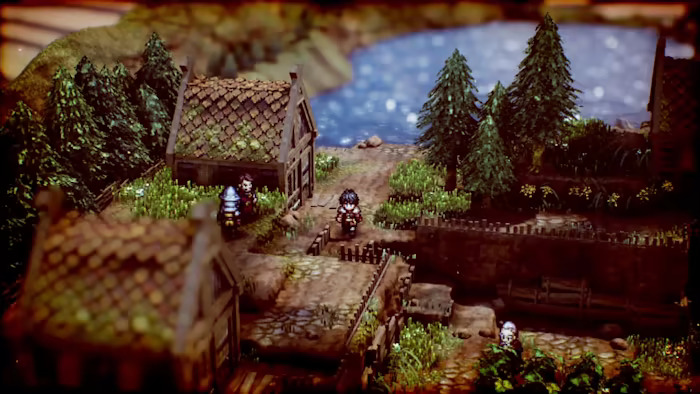
This last tip is mostly common knowledge for JRPG players, but even more important for strategy games. Saving is thankfully not as punishing as it used to be, or as some strategy games intentionally make it, but you never know what might happen in a long, story-heavy game with tough-as-nails battles. Rotating your saves, which means saving in multiple save slots rather than just having your one most current save slot, is just an extra bit of insurance that you never lose too much progress.
Triangle Strategy has two save systems: Autosave and manual saves. Autosaves are out of your control, but you can trigger manual saves you from your Encampment whenever you have access to it. Whether you want to go back because you missed a side quest, or if the worst should happen and your save gets corrupted, you never know when a backup save file will come in handy. There’s nothing worse than losing hours of progress, or even your entire adventure, in a game that is so deep and long like Triangle Strategy, so play it safe and rotate those save slots.
Editors' Recommendations
- The best Wordle starting words, tips, and tricks for beginners
- The best Palworld tips and tricks for beginners
- Cities: Skylines II beginner’s guide: tips and tricks to get started
- Dave the Diver: tips and tricks for conquering the undersea adventure
- BattleBit Remastered: tips and tricks for winning the 245-player shooter



